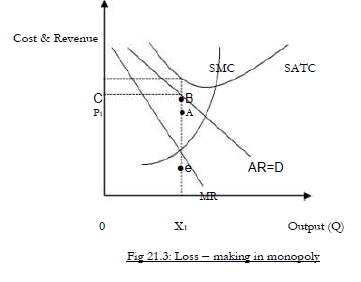A monopolist is a single seller in any market. The seller constitutes the industry and there are no close
substitutes for the product and there exists barriers to entry in the industry. In the short run, a monopolist
can make a loss even when he is producing where MR = MC. This is illustrated below:

A monopolist faces a downward sloping demand curve since he is a price maker and quantity setter. The AR
curve is the Demand curve. Since the curve (AR) is downward sloping, MR will always be less than price
since the firm must reduce the price of all units of output, not just the extra unit in order to sell that extra
unit.The monopolist is at equilibrium where MC = MR. This is at the output level of OX1. . The price
charged by the monopolist is OP 1 and the average cost is OC. Since the average cost is greater than the
average revenue at equilibrium the firm makes a loss. Total Cost is defined by OX1 BC while total revenue is
the area OX1 AP1 . The firm thus makes a loss equal to P1 ABC, the shaded area.
Wilfykil answered the question on
February 6, 2019 at 08:38